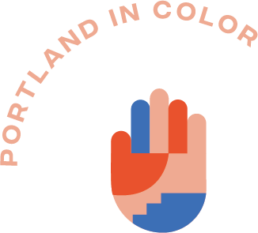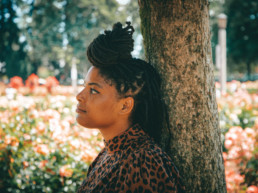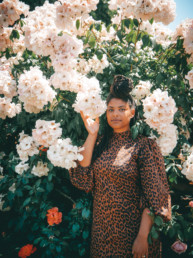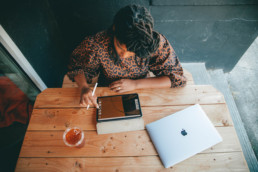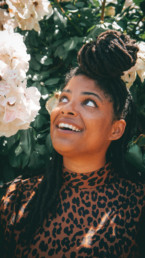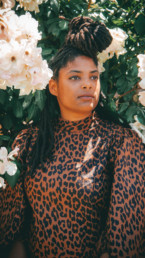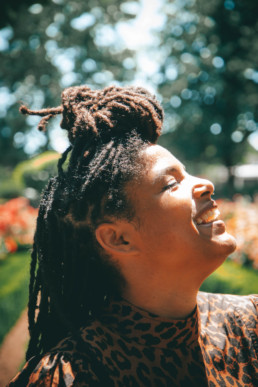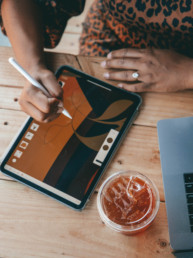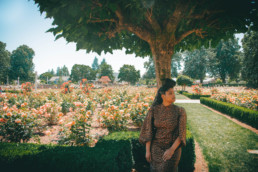PAULA CHAMPAGNE
“Nature is so restorative and healing. It’s really been a balm for me…”
Name: Paula Champagne
Pronouns: she/her
Background: I’m Black, period. [laughs] That’s all we know for sure. I grew up in Illinois near Chicago. My parents are from the South, and did the whole Great Migration that a lot of Black folks did. I got to Portland very recently.
Medium of choice: Multimedia. Video and illustration. Design and photography. And some tactile arts too. So I do a lot of things. It’s kind of hard to couch it.
Astrological Sign: Cancer
Favorite snack: I’m really into popcorn right now. So I like to mix a cheddar and a kettle corn. I like to get a good blend going.
Karaoke jam: I’ve never performed this but I think it would be a Lizzo song, like “Cuz I Love You”
Local artists you’re excited about: Darren Todd
INSTAGRAM
@makerchamp
Over a year after 2020’s anti-racist uprisings, for many BIPOC, attempts at diversity in art and media can feel trite, like those with power and privilege are just trying to shove a Black or brown face in front of a camera without asking any meaningful questions about what it means to be us. Champagne answers this question by specifically exploring Black people and the natural world—imagining a world where Black people, specifically Black women, are not just seen, but thriving and healing.
A mere two percent of visitors to National Parks are Black. This is no surprise given that National Park Services has been historically segregated, consistently white washes white supremacist violence, and is run by an all-white board. White supremacy dominatesoutdoor culture—a culture that exists on stolen land—but rarely acknowledges Indigenous genocide or the history of enslavementby the previous stewards of many national parks. After working for the National Parks Service and feeling burnt out from the racism within that space, Champagne found healing in developing a personal relationship with nature. Now, through her art, she produces images which explore Black people finding joy in the outdoors—a radical reconnection.
Champagne is a multitalented visual artist and documentary filmmaker. She is new to Portland, but her and her art will be right at home here. In the whitest major city in the United States with a voracious outdoor culture, Champagne challenges us to wonder what might stand between people of color and the joy that can be found in connecting with the natural world.
Tell us some more about your background.
I’m Black, period. [laughs] That’s all we know for sure. I grew up in Illinois near Chicago. My parents are from the South, and did the whole Great Migration that a lot of Black folks did. I got to Portland very recently. [Before arriving in Portland], I moved to Boston after school. My brother used to live there and I just kind of didn’t know what I wanted to do with my life after I graduated undergrad, and so he convinced me to live with him for free! I ended up staying for 11 years! I met a lot of great people, met my spouse. It worked out, but it was time to leave Boston. I got to Portland very recently. My partner and I were able to move wherever we wanted because of the remote work flexibility that was made possible during these wild times. The lush foliage in the PNW brought me here! I fell in love with the green landscape in the spring, and we always wanted to live on the west coast.
“I think when I started to identify that connection with the outdoors I started having things to say and it became a more clear voice. And then I’ve worked over the last four or five years to sort of figure out what that meant in each medium.”
When did your artistic journey begin? How did you start doing art the way you’re doing it now?
I think I was an artist since I was a little kid, since I was maybe four. I was always writing, I don’t write anymore, and drawing and making books and stuff. When I started to grow up and started to think about my career my parents were very much like, “You can’t be an artist, so pick something practical.” And so I chose graphic design, which was fine but I think kind of made me feel like I wasn’t an artist for a while. So I didn’t really start identifying as an artist until probably five or six years ago.
What changed then?
I think it was really when my connection to nature became clear to me, a clear inspiration. I think that’s when a kind of a shift started to happen and I felt like I had a voice. Cause before I painted a lot and drew a lot but it was just kind of mimicking what I saw. There was no point. I wasn’t saying anything.
I think when I started to identify that connection with the outdoors I started having things to say and it became a more clear voice. And then I’ve worked over the last four or five years to sort of figure out what that meant in each medium.
What’s inspiring you the most right now?
Being here! Being in a new place. Seeing these giant trees! All this green…seeing spring blooming has been really refreshing. Being here has just been like…suddenly refreshing.
Your work seems to revolve mostly around Blackness, Black womanhood, childhood and history—but there’s also a strong incorporation of nature and foliage in your work. Where do both those influences come from and why the marriage between them?
Nature is so restorative and healing. It’s really been a balm for me, and with that there’s been kind of a lack of seeing people that look like me in the spaces of typical recreational outdoor activities. That’s not to mean that Black folks aren’t doing things in nature, it [just] doesn’t fit into the archetype of what it means to be “outdoorsy.” I feel like there’s been a resurgence lately. And so I started to want to focus on creating things that I wish I saw, and creating from that ache of wanting that marriage to be more represented. Who needs the healing and representation more than Black people? Especially Black women and femmes. We have it harder. It’s bad! [laughs] So, that’s kind of how that happened. This is what I want for my community and people that look like me, and so that’s when I kind of merged those things.
Was there a catalyst to nature becoming so healing for you? You talk about it in this way that makes it seem like something shifted.
I started working in the outdoor industry. That’s when I really started to think about it, and really started to not like that community, and not like how it was marketed to people, not like how it was represented. So my art just kind of became my retaliation against that. My resistance against that.
There’s so much history behind why there’s a lack of Black folks in the outdoor industry. It’s intentional. National Parks intentionally excluded Black people and marketed themselves towards white people to get away from urban sprawl. There’s bad generational trauma that happened in the woods. A lot of that! And a lot of my family is like ‘Why would you camp when we paid for you to have a home growing up? We worked our asses off!’
What’s your dream project?
I’m working on a dream right now! I’m working on a documentary and that feels like a dream to me. It’s a short one. I got my first film grant. It’s one of the first pieces that I’ve done in a long time that’s not for a corporation. Even that just feels great. It’s about my friend Mardi (Mardi’s instagram is @fattoosday), who’s this Black woman that has broken a lot of barriers in the hiking community in New Hampshire. It’s all about her navigating that. She’s been exploring the landscape for 20 years, so it’s all about what sacrifices she’s made by being in those spaces and what joys she has. That’s been a dream that I’m working on.
A dream in the future would be a long form documentary and I really want to work on some big murals. I’ve only done small ones. I would also love to have my own show in a gallery someday! I don’t know how I could forget that dream.
What do you like about the process and the art of documentary filmmaking?
It’s really just storytelling and honoring the subject. Honoring the person. Really reaching to find that authenticity they have and show that to people. It’s very magical. A lot of people feel like they don’t have anything interesting to say, and then I’ve found that some of the pieces I do, afterwards they’ll appreciate themselves more. So there’s kind of a magic to that that I really like.
What’s inspiring you the most right now?
Being here! Being in a new place. Seeing these giant trees! All this green…seeing spring blooming has been really refreshing. Being here has just been like…suddenly refreshing.
Any other artists who really inspire you?
I love Gordon Parks photography. There’s a lot of, like, very vivid, candid shots of Black people living their lives out in the outdoors in different ways. Most of it was out in the Deep South and Jim Crow South, which my family’s from, so his work is very inspirational to me. Latasha Dunstin, that’s another illustrator I really love. She’s also a Black woman that does a lot of nature-y sort of inspirational art. There’s not a lot of us in this intersection. She’s great. Bisa Butler’s another artist who I find inspiring. She does like colors, and layering. She works with a lot of textiles. It’s really cool.
What do you think your work contributes to the project of moving past simple diversity politics? What do you think your work brings to the BIPOC art scene in general?
I think mine, especially my fine art work, my illustration work, it’s really more about the restorative and healing connection between our community and the outdoors. I think it goes deeper than, ‘Wow! There’s not many of us!’ and has a nuance. And I keep doing it over and over.
You can purchase Paula’s prints at https://www.vsual.co/shop/paulachampagne
This work was made possible in part to a Make | Learn | Build Grant from the Regional Arts and Cultural Council.
